Fall Risk Factors and Prevention Strategies
VerifiedAdded on 2020/05/28
|8
|2368
|100
AI Summary
This assignment delves into the multifaceted issue of falls among older adults. It requires an analysis of contributing factors such as medical conditions (COPD), medications, vitamin D deficiency, executive function, and fall risk-increasing drugs. The assignment also emphasizes the importance of evidence-based prevention strategies, including exercise programs, vitamin D supplementation, tai chi training, and fall risk screening tools.
Contribute Materials
Your contribution can guide someone’s learning journey. Share your
documents today.
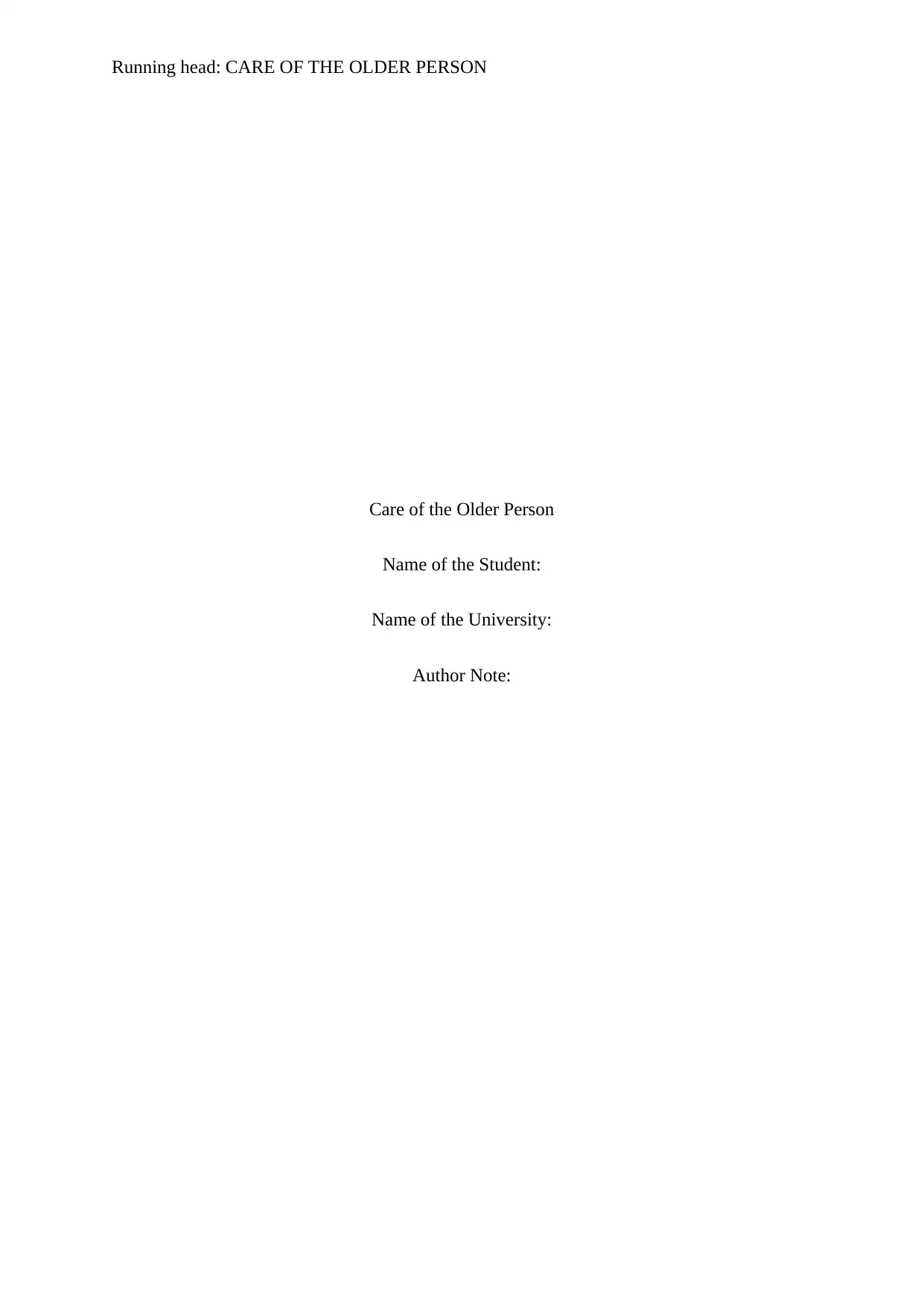
Running head: CARE OF THE OLDER PERSON
Care of the Older Person
Name of the Student:
Name of the University:
Author Note:
Care of the Older Person
Name of the Student:
Name of the University:
Author Note:
Secure Best Marks with AI Grader
Need help grading? Try our AI Grader for instant feedback on your assignments.
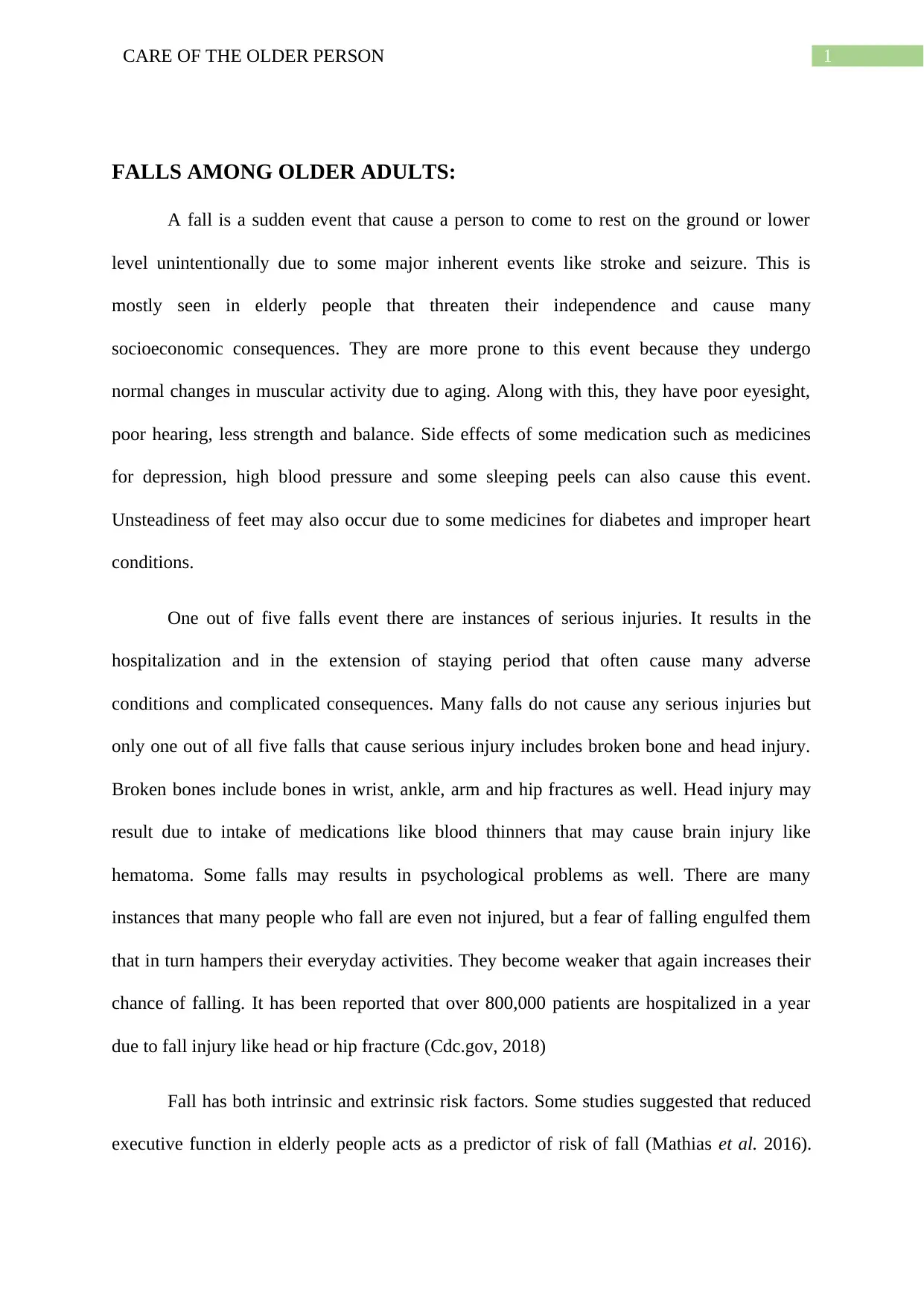
1CARE OF THE OLDER PERSON
FALLS AMONG OLDER ADULTS:
A fall is a sudden event that cause a person to come to rest on the ground or lower
level unintentionally due to some major inherent events like stroke and seizure. This is
mostly seen in elderly people that threaten their independence and cause many
socioeconomic consequences. They are more prone to this event because they undergo
normal changes in muscular activity due to aging. Along with this, they have poor eyesight,
poor hearing, less strength and balance. Side effects of some medication such as medicines
for depression, high blood pressure and some sleeping peels can also cause this event.
Unsteadiness of feet may also occur due to some medicines for diabetes and improper heart
conditions.
One out of five falls event there are instances of serious injuries. It results in the
hospitalization and in the extension of staying period that often cause many adverse
conditions and complicated consequences. Many falls do not cause any serious injuries but
only one out of all five falls that cause serious injury includes broken bone and head injury.
Broken bones include bones in wrist, ankle, arm and hip fractures as well. Head injury may
result due to intake of medications like blood thinners that may cause brain injury like
hematoma. Some falls may results in psychological problems as well. There are many
instances that many people who fall are even not injured, but a fear of falling engulfed them
that in turn hampers their everyday activities. They become weaker that again increases their
chance of falling. It has been reported that over 800,000 patients are hospitalized in a year
due to fall injury like head or hip fracture (Cdc.gov, 2018)
Fall has both intrinsic and extrinsic risk factors. Some studies suggested that reduced
executive function in elderly people acts as a predictor of risk of fall (Mathias et al. 2016).
FALLS AMONG OLDER ADULTS:
A fall is a sudden event that cause a person to come to rest on the ground or lower
level unintentionally due to some major inherent events like stroke and seizure. This is
mostly seen in elderly people that threaten their independence and cause many
socioeconomic consequences. They are more prone to this event because they undergo
normal changes in muscular activity due to aging. Along with this, they have poor eyesight,
poor hearing, less strength and balance. Side effects of some medication such as medicines
for depression, high blood pressure and some sleeping peels can also cause this event.
Unsteadiness of feet may also occur due to some medicines for diabetes and improper heart
conditions.
One out of five falls event there are instances of serious injuries. It results in the
hospitalization and in the extension of staying period that often cause many adverse
conditions and complicated consequences. Many falls do not cause any serious injuries but
only one out of all five falls that cause serious injury includes broken bone and head injury.
Broken bones include bones in wrist, ankle, arm and hip fractures as well. Head injury may
result due to intake of medications like blood thinners that may cause brain injury like
hematoma. Some falls may results in psychological problems as well. There are many
instances that many people who fall are even not injured, but a fear of falling engulfed them
that in turn hampers their everyday activities. They become weaker that again increases their
chance of falling. It has been reported that over 800,000 patients are hospitalized in a year
due to fall injury like head or hip fracture (Cdc.gov, 2018)
Fall has both intrinsic and extrinsic risk factors. Some studies suggested that reduced
executive function in elderly people acts as a predictor of risk of fall (Mathias et al. 2016).
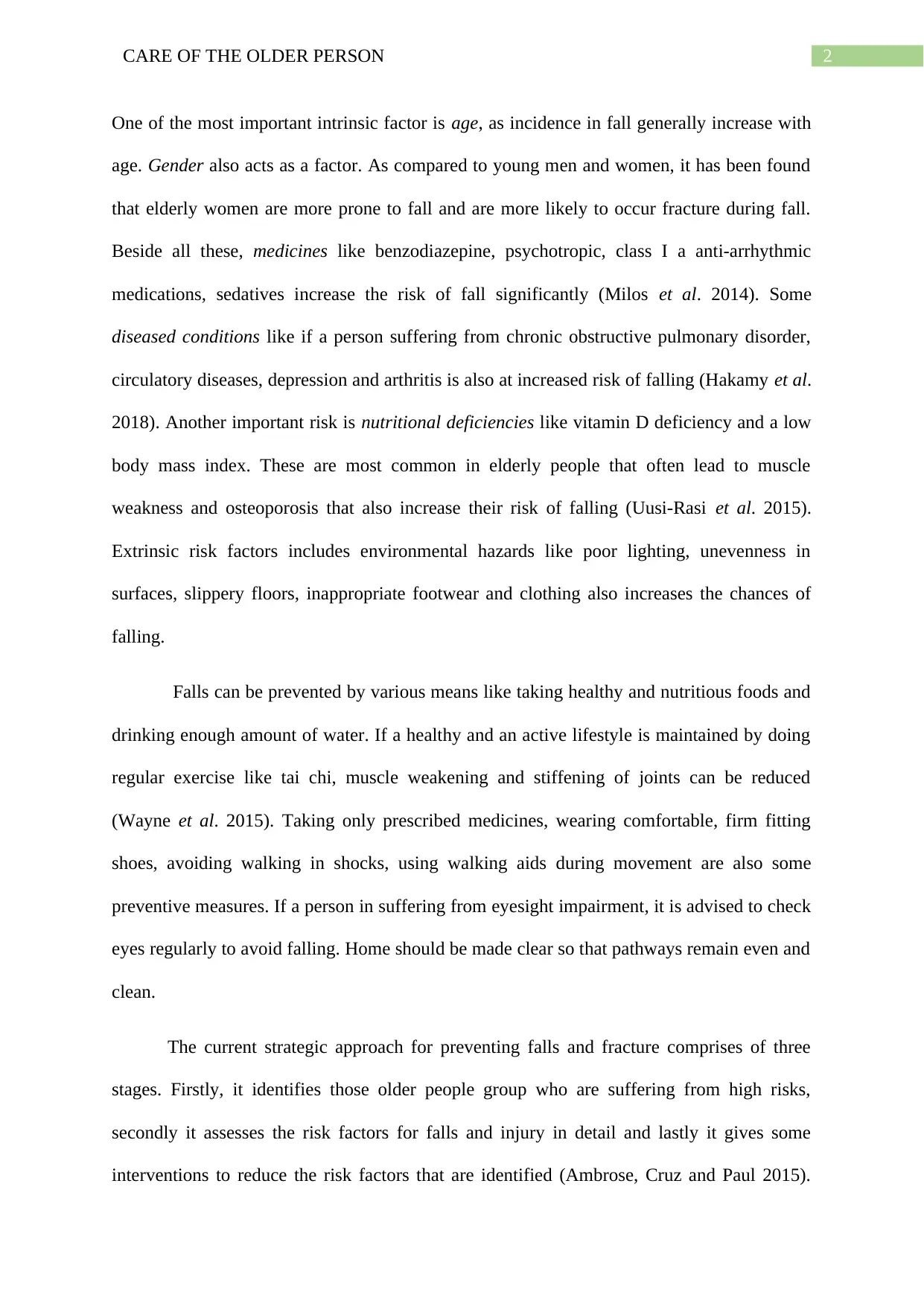
2CARE OF THE OLDER PERSON
One of the most important intrinsic factor is age, as incidence in fall generally increase with
age. Gender also acts as a factor. As compared to young men and women, it has been found
that elderly women are more prone to fall and are more likely to occur fracture during fall.
Beside all these, medicines like benzodiazepine, psychotropic, class I a anti-arrhythmic
medications, sedatives increase the risk of fall significantly (Milos et al. 2014). Some
diseased conditions like if a person suffering from chronic obstructive pulmonary disorder,
circulatory diseases, depression and arthritis is also at increased risk of falling (Hakamy et al.
2018). Another important risk is nutritional deficiencies like vitamin D deficiency and a low
body mass index. These are most common in elderly people that often lead to muscle
weakness and osteoporosis that also increase their risk of falling (Uusi-Rasi et al. 2015).
Extrinsic risk factors includes environmental hazards like poor lighting, unevenness in
surfaces, slippery floors, inappropriate footwear and clothing also increases the chances of
falling.
Falls can be prevented by various means like taking healthy and nutritious foods and
drinking enough amount of water. If a healthy and an active lifestyle is maintained by doing
regular exercise like tai chi, muscle weakening and stiffening of joints can be reduced
(Wayne et al. 2015). Taking only prescribed medicines, wearing comfortable, firm fitting
shoes, avoiding walking in shocks, using walking aids during movement are also some
preventive measures. If a person in suffering from eyesight impairment, it is advised to check
eyes regularly to avoid falling. Home should be made clear so that pathways remain even and
clean.
The current strategic approach for preventing falls and fracture comprises of three
stages. Firstly, it identifies those older people group who are suffering from high risks,
secondly it assesses the risk factors for falls and injury in detail and lastly it gives some
interventions to reduce the risk factors that are identified (Ambrose, Cruz and Paul 2015).
One of the most important intrinsic factor is age, as incidence in fall generally increase with
age. Gender also acts as a factor. As compared to young men and women, it has been found
that elderly women are more prone to fall and are more likely to occur fracture during fall.
Beside all these, medicines like benzodiazepine, psychotropic, class I a anti-arrhythmic
medications, sedatives increase the risk of fall significantly (Milos et al. 2014). Some
diseased conditions like if a person suffering from chronic obstructive pulmonary disorder,
circulatory diseases, depression and arthritis is also at increased risk of falling (Hakamy et al.
2018). Another important risk is nutritional deficiencies like vitamin D deficiency and a low
body mass index. These are most common in elderly people that often lead to muscle
weakness and osteoporosis that also increase their risk of falling (Uusi-Rasi et al. 2015).
Extrinsic risk factors includes environmental hazards like poor lighting, unevenness in
surfaces, slippery floors, inappropriate footwear and clothing also increases the chances of
falling.
Falls can be prevented by various means like taking healthy and nutritious foods and
drinking enough amount of water. If a healthy and an active lifestyle is maintained by doing
regular exercise like tai chi, muscle weakening and stiffening of joints can be reduced
(Wayne et al. 2015). Taking only prescribed medicines, wearing comfortable, firm fitting
shoes, avoiding walking in shocks, using walking aids during movement are also some
preventive measures. If a person in suffering from eyesight impairment, it is advised to check
eyes regularly to avoid falling. Home should be made clear so that pathways remain even and
clean.
The current strategic approach for preventing falls and fracture comprises of three
stages. Firstly, it identifies those older people group who are suffering from high risks,
secondly it assesses the risk factors for falls and injury in detail and lastly it gives some
interventions to reduce the risk factors that are identified (Ambrose, Cruz and Paul 2015).
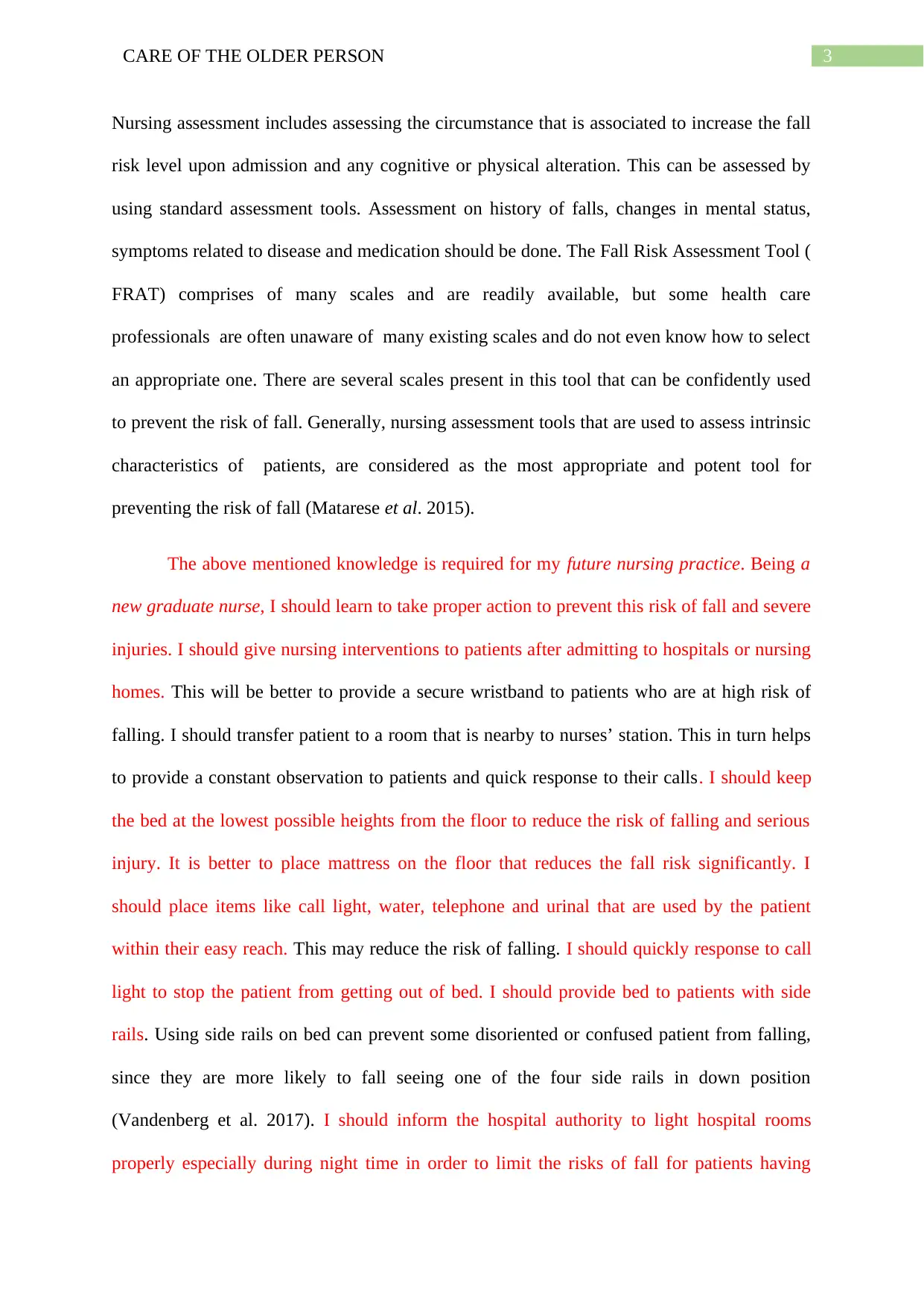
3CARE OF THE OLDER PERSON
Nursing assessment includes assessing the circumstance that is associated to increase the fall
risk level upon admission and any cognitive or physical alteration. This can be assessed by
using standard assessment tools. Assessment on history of falls, changes in mental status,
symptoms related to disease and medication should be done. The Fall Risk Assessment Tool (
FRAT) comprises of many scales and are readily available, but some health care
professionals are often unaware of many existing scales and do not even know how to select
an appropriate one. There are several scales present in this tool that can be confidently used
to prevent the risk of fall. Generally, nursing assessment tools that are used to assess intrinsic
characteristics of patients, are considered as the most appropriate and potent tool for
preventing the risk of fall (Matarese et al. 2015).
The above mentioned knowledge is required for my future nursing practice. Being a
new graduate nurse, I should learn to take proper action to prevent this risk of fall and severe
injuries. I should give nursing interventions to patients after admitting to hospitals or nursing
homes. This will be better to provide a secure wristband to patients who are at high risk of
falling. I should transfer patient to a room that is nearby to nurses’ station. This in turn helps
to provide a constant observation to patients and quick response to their calls. I should keep
the bed at the lowest possible heights from the floor to reduce the risk of falling and serious
injury. It is better to place mattress on the floor that reduces the fall risk significantly. I
should place items like call light, water, telephone and urinal that are used by the patient
within their easy reach. This may reduce the risk of falling. I should quickly response to call
light to stop the patient from getting out of bed. I should provide bed to patients with side
rails. Using side rails on bed can prevent some disoriented or confused patient from falling,
since they are more likely to fall seeing one of the four side rails in down position
(Vandenberg et al. 2017). I should inform the hospital authority to light hospital rooms
properly especially during night time in order to limit the risks of fall for patients having
Nursing assessment includes assessing the circumstance that is associated to increase the fall
risk level upon admission and any cognitive or physical alteration. This can be assessed by
using standard assessment tools. Assessment on history of falls, changes in mental status,
symptoms related to disease and medication should be done. The Fall Risk Assessment Tool (
FRAT) comprises of many scales and are readily available, but some health care
professionals are often unaware of many existing scales and do not even know how to select
an appropriate one. There are several scales present in this tool that can be confidently used
to prevent the risk of fall. Generally, nursing assessment tools that are used to assess intrinsic
characteristics of patients, are considered as the most appropriate and potent tool for
preventing the risk of fall (Matarese et al. 2015).
The above mentioned knowledge is required for my future nursing practice. Being a
new graduate nurse, I should learn to take proper action to prevent this risk of fall and severe
injuries. I should give nursing interventions to patients after admitting to hospitals or nursing
homes. This will be better to provide a secure wristband to patients who are at high risk of
falling. I should transfer patient to a room that is nearby to nurses’ station. This in turn helps
to provide a constant observation to patients and quick response to their calls. I should keep
the bed at the lowest possible heights from the floor to reduce the risk of falling and serious
injury. It is better to place mattress on the floor that reduces the fall risk significantly. I
should place items like call light, water, telephone and urinal that are used by the patient
within their easy reach. This may reduce the risk of falling. I should quickly response to call
light to stop the patient from getting out of bed. I should provide bed to patients with side
rails. Using side rails on bed can prevent some disoriented or confused patient from falling,
since they are more likely to fall seeing one of the four side rails in down position
(Vandenberg et al. 2017). I should inform the hospital authority to light hospital rooms
properly especially during night time in order to limit the risks of fall for patients having
Secure Best Marks with AI Grader
Need help grading? Try our AI Grader for instant feedback on your assignments.
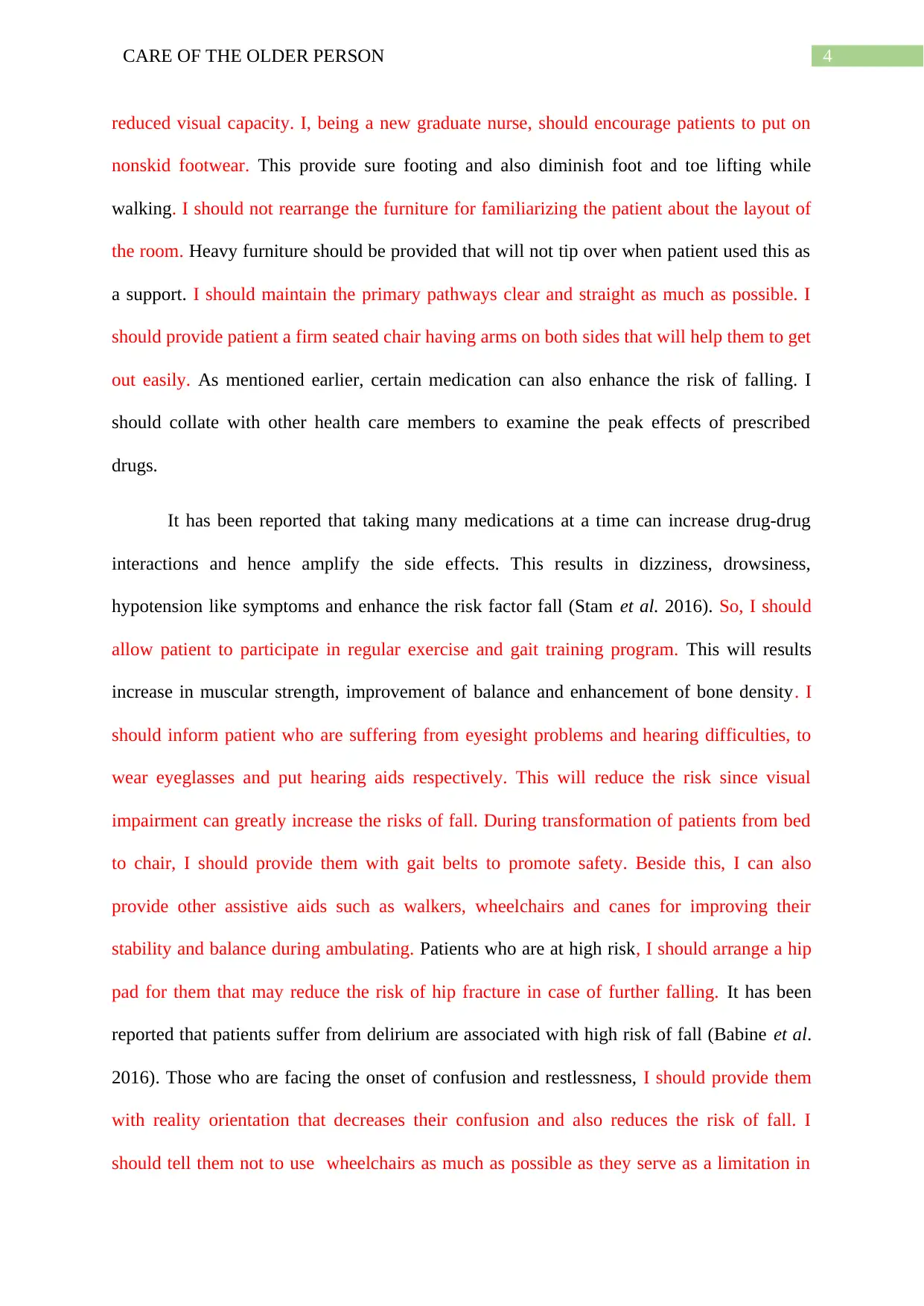
4CARE OF THE OLDER PERSON
reduced visual capacity. I, being a new graduate nurse, should encourage patients to put on
nonskid footwear. This provide sure footing and also diminish foot and toe lifting while
walking. I should not rearrange the furniture for familiarizing the patient about the layout of
the room. Heavy furniture should be provided that will not tip over when patient used this as
a support. I should maintain the primary pathways clear and straight as much as possible. I
should provide patient a firm seated chair having arms on both sides that will help them to get
out easily. As mentioned earlier, certain medication can also enhance the risk of falling. I
should collate with other health care members to examine the peak effects of prescribed
drugs.
It has been reported that taking many medications at a time can increase drug-drug
interactions and hence amplify the side effects. This results in dizziness, drowsiness,
hypotension like symptoms and enhance the risk factor fall (Stam et al. 2016). So, I should
allow patient to participate in regular exercise and gait training program. This will results
increase in muscular strength, improvement of balance and enhancement of bone density. I
should inform patient who are suffering from eyesight problems and hearing difficulties, to
wear eyeglasses and put hearing aids respectively. This will reduce the risk since visual
impairment can greatly increase the risks of fall. During transformation of patients from bed
to chair, I should provide them with gait belts to promote safety. Beside this, I can also
provide other assistive aids such as walkers, wheelchairs and canes for improving their
stability and balance during ambulating. Patients who are at high risk, I should arrange a hip
pad for them that may reduce the risk of hip fracture in case of further falling. It has been
reported that patients suffer from delirium are associated with high risk of fall (Babine et al.
2016). Those who are facing the onset of confusion and restlessness, I should provide them
with reality orientation that decreases their confusion and also reduces the risk of fall. I
should tell them not to use wheelchairs as much as possible as they serve as a limitation in
reduced visual capacity. I, being a new graduate nurse, should encourage patients to put on
nonskid footwear. This provide sure footing and also diminish foot and toe lifting while
walking. I should not rearrange the furniture for familiarizing the patient about the layout of
the room. Heavy furniture should be provided that will not tip over when patient used this as
a support. I should maintain the primary pathways clear and straight as much as possible. I
should provide patient a firm seated chair having arms on both sides that will help them to get
out easily. As mentioned earlier, certain medication can also enhance the risk of falling. I
should collate with other health care members to examine the peak effects of prescribed
drugs.
It has been reported that taking many medications at a time can increase drug-drug
interactions and hence amplify the side effects. This results in dizziness, drowsiness,
hypotension like symptoms and enhance the risk factor fall (Stam et al. 2016). So, I should
allow patient to participate in regular exercise and gait training program. This will results
increase in muscular strength, improvement of balance and enhancement of bone density. I
should inform patient who are suffering from eyesight problems and hearing difficulties, to
wear eyeglasses and put hearing aids respectively. This will reduce the risk since visual
impairment can greatly increase the risks of fall. During transformation of patients from bed
to chair, I should provide them with gait belts to promote safety. Beside this, I can also
provide other assistive aids such as walkers, wheelchairs and canes for improving their
stability and balance during ambulating. Patients who are at high risk, I should arrange a hip
pad for them that may reduce the risk of hip fracture in case of further falling. It has been
reported that patients suffer from delirium are associated with high risk of fall (Babine et al.
2016). Those who are facing the onset of confusion and restlessness, I should provide them
with reality orientation that decreases their confusion and also reduces the risk of fall. I
should tell them not to use wheelchairs as much as possible as they serve as a limitation in
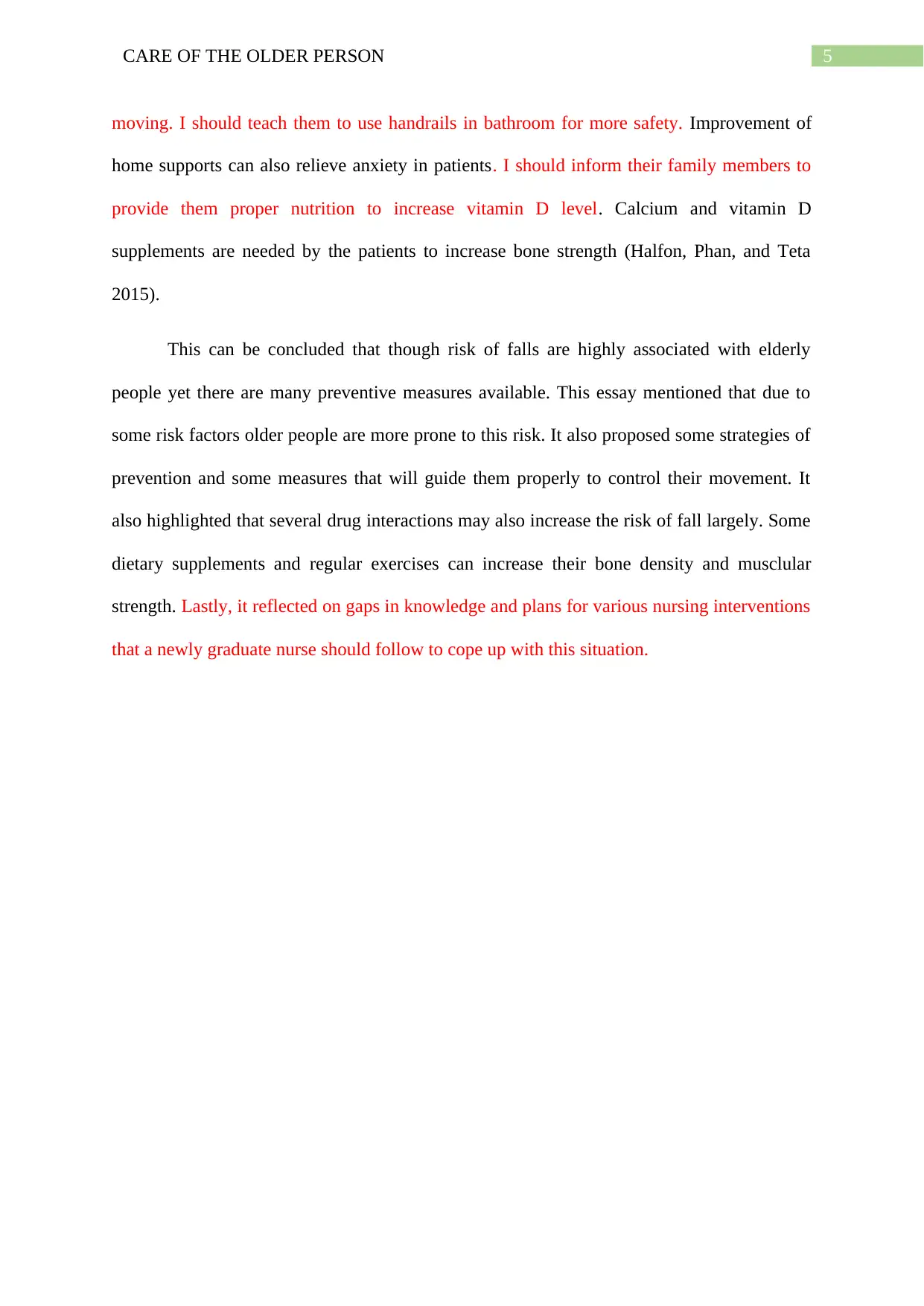
5CARE OF THE OLDER PERSON
moving. I should teach them to use handrails in bathroom for more safety. Improvement of
home supports can also relieve anxiety in patients. I should inform their family members to
provide them proper nutrition to increase vitamin D level. Calcium and vitamin D
supplements are needed by the patients to increase bone strength (Halfon, Phan, and Teta
2015).
This can be concluded that though risk of falls are highly associated with elderly
people yet there are many preventive measures available. This essay mentioned that due to
some risk factors older people are more prone to this risk. It also proposed some strategies of
prevention and some measures that will guide them properly to control their movement. It
also highlighted that several drug interactions may also increase the risk of fall largely. Some
dietary supplements and regular exercises can increase their bone density and musclular
strength. Lastly, it reflected on gaps in knowledge and plans for various nursing interventions
that a newly graduate nurse should follow to cope up with this situation.
moving. I should teach them to use handrails in bathroom for more safety. Improvement of
home supports can also relieve anxiety in patients. I should inform their family members to
provide them proper nutrition to increase vitamin D level. Calcium and vitamin D
supplements are needed by the patients to increase bone strength (Halfon, Phan, and Teta
2015).
This can be concluded that though risk of falls are highly associated with elderly
people yet there are many preventive measures available. This essay mentioned that due to
some risk factors older people are more prone to this risk. It also proposed some strategies of
prevention and some measures that will guide them properly to control their movement. It
also highlighted that several drug interactions may also increase the risk of fall largely. Some
dietary supplements and regular exercises can increase their bone density and musclular
strength. Lastly, it reflected on gaps in knowledge and plans for various nursing interventions
that a newly graduate nurse should follow to cope up with this situation.
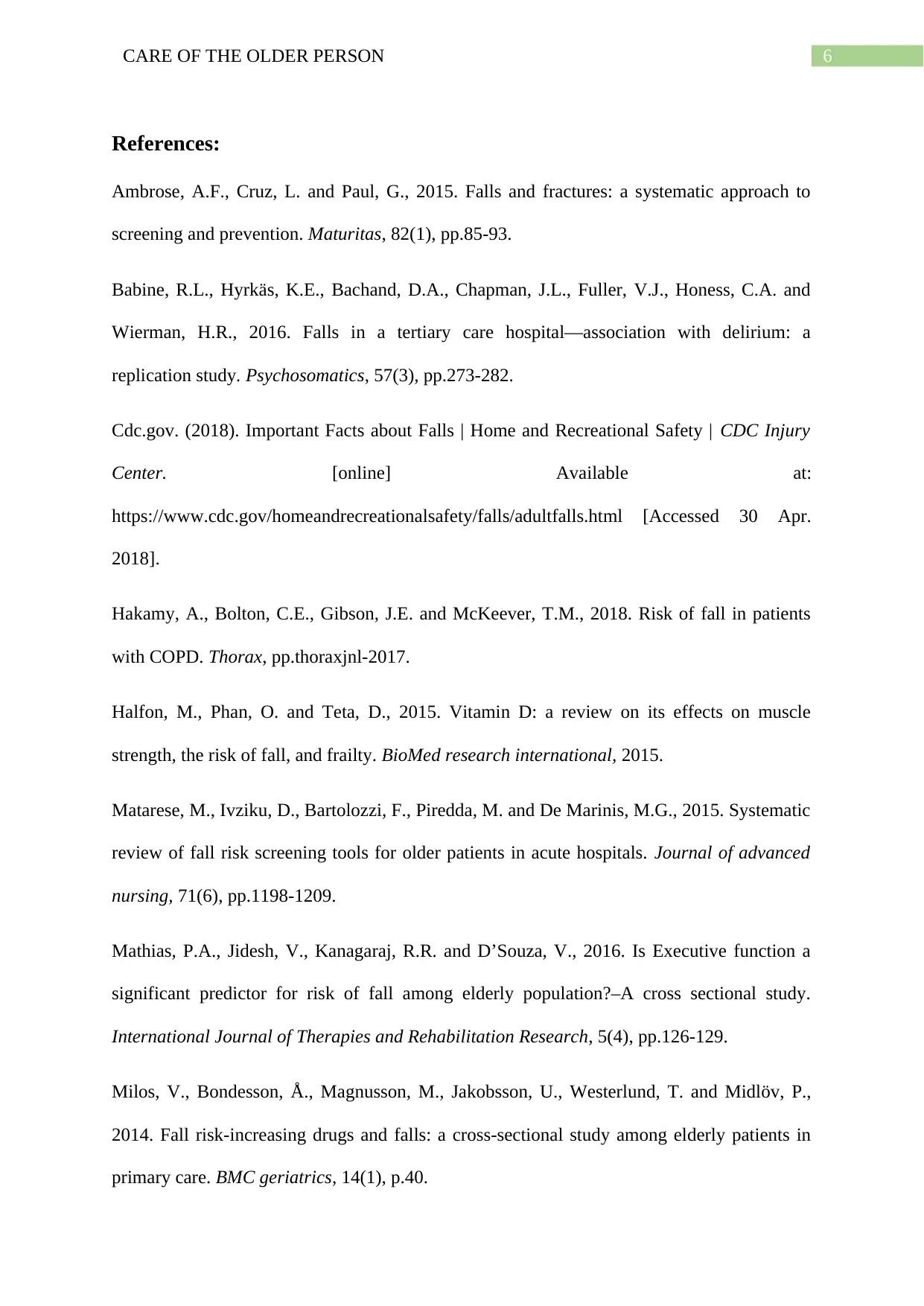
6CARE OF THE OLDER PERSON
References:
Ambrose, A.F., Cruz, L. and Paul, G., 2015. Falls and fractures: a systematic approach to
screening and prevention. Maturitas, 82(1), pp.85-93.
Babine, R.L., Hyrkäs, K.E., Bachand, D.A., Chapman, J.L., Fuller, V.J., Honess, C.A. and
Wierman, H.R., 2016. Falls in a tertiary care hospital—association with delirium: a
replication study. Psychosomatics, 57(3), pp.273-282.
Cdc.gov. (2018). Important Facts about Falls | Home and Recreational Safety | CDC Injury
Center. [online] Available at:
https://www.cdc.gov/homeandrecreationalsafety/falls/adultfalls.html [Accessed 30 Apr.
2018].
Hakamy, A., Bolton, C.E., Gibson, J.E. and McKeever, T.M., 2018. Risk of fall in patients
with COPD. Thorax, pp.thoraxjnl-2017.
Halfon, M., Phan, O. and Teta, D., 2015. Vitamin D: a review on its effects on muscle
strength, the risk of fall, and frailty. BioMed research international, 2015.
Matarese, M., Ivziku, D., Bartolozzi, F., Piredda, M. and De Marinis, M.G., 2015. Systematic
review of fall risk screening tools for older patients in acute hospitals. Journal of advanced
nursing, 71(6), pp.1198-1209.
Mathias, P.A., Jidesh, V., Kanagaraj, R.R. and D’Souza, V., 2016. Is Executive function a
significant predictor for risk of fall among elderly population?–A cross sectional study.
International Journal of Therapies and Rehabilitation Research, 5(4), pp.126-129.
Milos, V., Bondesson, Å., Magnusson, M., Jakobsson, U., Westerlund, T. and Midlöv, P.,
2014. Fall risk-increasing drugs and falls: a cross-sectional study among elderly patients in
primary care. BMC geriatrics, 14(1), p.40.
References:
Ambrose, A.F., Cruz, L. and Paul, G., 2015. Falls and fractures: a systematic approach to
screening and prevention. Maturitas, 82(1), pp.85-93.
Babine, R.L., Hyrkäs, K.E., Bachand, D.A., Chapman, J.L., Fuller, V.J., Honess, C.A. and
Wierman, H.R., 2016. Falls in a tertiary care hospital—association with delirium: a
replication study. Psychosomatics, 57(3), pp.273-282.
Cdc.gov. (2018). Important Facts about Falls | Home and Recreational Safety | CDC Injury
Center. [online] Available at:
https://www.cdc.gov/homeandrecreationalsafety/falls/adultfalls.html [Accessed 30 Apr.
2018].
Hakamy, A., Bolton, C.E., Gibson, J.E. and McKeever, T.M., 2018. Risk of fall in patients
with COPD. Thorax, pp.thoraxjnl-2017.
Halfon, M., Phan, O. and Teta, D., 2015. Vitamin D: a review on its effects on muscle
strength, the risk of fall, and frailty. BioMed research international, 2015.
Matarese, M., Ivziku, D., Bartolozzi, F., Piredda, M. and De Marinis, M.G., 2015. Systematic
review of fall risk screening tools for older patients in acute hospitals. Journal of advanced
nursing, 71(6), pp.1198-1209.
Mathias, P.A., Jidesh, V., Kanagaraj, R.R. and D’Souza, V., 2016. Is Executive function a
significant predictor for risk of fall among elderly population?–A cross sectional study.
International Journal of Therapies and Rehabilitation Research, 5(4), pp.126-129.
Milos, V., Bondesson, Å., Magnusson, M., Jakobsson, U., Westerlund, T. and Midlöv, P.,
2014. Fall risk-increasing drugs and falls: a cross-sectional study among elderly patients in
primary care. BMC geriatrics, 14(1), p.40.
Paraphrase This Document
Need a fresh take? Get an instant paraphrase of this document with our AI Paraphraser
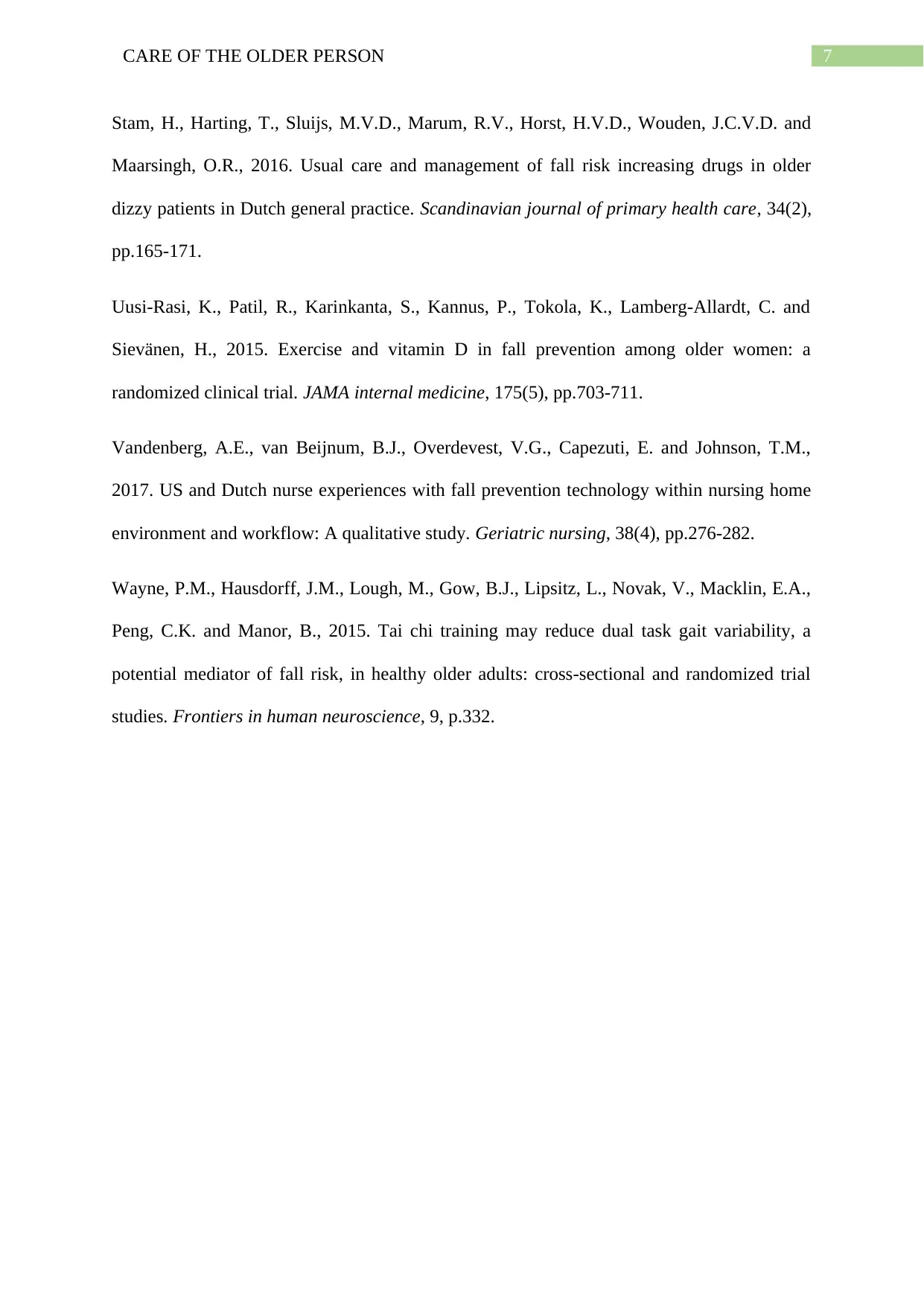
7CARE OF THE OLDER PERSON
Stam, H., Harting, T., Sluijs, M.V.D., Marum, R.V., Horst, H.V.D., Wouden, J.C.V.D. and
Maarsingh, O.R., 2016. Usual care and management of fall risk increasing drugs in older
dizzy patients in Dutch general practice. Scandinavian journal of primary health care, 34(2),
pp.165-171.
Uusi-Rasi, K., Patil, R., Karinkanta, S., Kannus, P., Tokola, K., Lamberg-Allardt, C. and
Sievänen, H., 2015. Exercise and vitamin D in fall prevention among older women: a
randomized clinical trial. JAMA internal medicine, 175(5), pp.703-711.
Vandenberg, A.E., van Beijnum, B.J., Overdevest, V.G., Capezuti, E. and Johnson, T.M.,
2017. US and Dutch nurse experiences with fall prevention technology within nursing home
environment and workflow: A qualitative study. Geriatric nursing, 38(4), pp.276-282.
Wayne, P.M., Hausdorff, J.M., Lough, M., Gow, B.J., Lipsitz, L., Novak, V., Macklin, E.A.,
Peng, C.K. and Manor, B., 2015. Tai chi training may reduce dual task gait variability, a
potential mediator of fall risk, in healthy older adults: cross-sectional and randomized trial
studies. Frontiers in human neuroscience, 9, p.332.
Stam, H., Harting, T., Sluijs, M.V.D., Marum, R.V., Horst, H.V.D., Wouden, J.C.V.D. and
Maarsingh, O.R., 2016. Usual care and management of fall risk increasing drugs in older
dizzy patients in Dutch general practice. Scandinavian journal of primary health care, 34(2),
pp.165-171.
Uusi-Rasi, K., Patil, R., Karinkanta, S., Kannus, P., Tokola, K., Lamberg-Allardt, C. and
Sievänen, H., 2015. Exercise and vitamin D in fall prevention among older women: a
randomized clinical trial. JAMA internal medicine, 175(5), pp.703-711.
Vandenberg, A.E., van Beijnum, B.J., Overdevest, V.G., Capezuti, E. and Johnson, T.M.,
2017. US and Dutch nurse experiences with fall prevention technology within nursing home
environment and workflow: A qualitative study. Geriatric nursing, 38(4), pp.276-282.
Wayne, P.M., Hausdorff, J.M., Lough, M., Gow, B.J., Lipsitz, L., Novak, V., Macklin, E.A.,
Peng, C.K. and Manor, B., 2015. Tai chi training may reduce dual task gait variability, a
potential mediator of fall risk, in healthy older adults: cross-sectional and randomized trial
studies. Frontiers in human neuroscience, 9, p.332.
1 out of 8
Related Documents
Your All-in-One AI-Powered Toolkit for Academic Success.
+13062052269
info@desklib.com
Available 24*7 on WhatsApp / Email
![[object Object]](/_next/static/media/star-bottom.7253800d.svg)
Unlock your academic potential
© 2024 | Zucol Services PVT LTD | All rights reserved.





